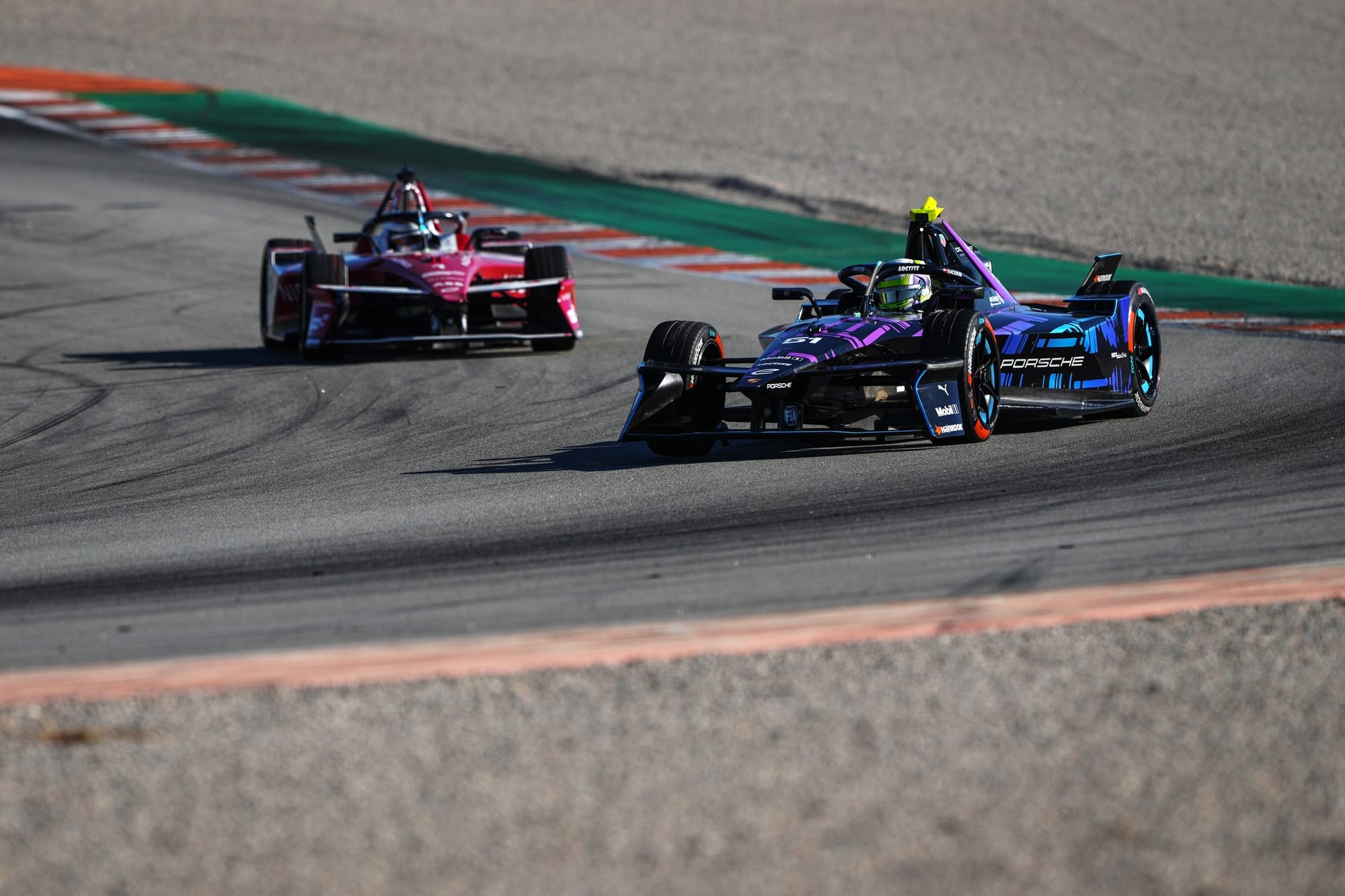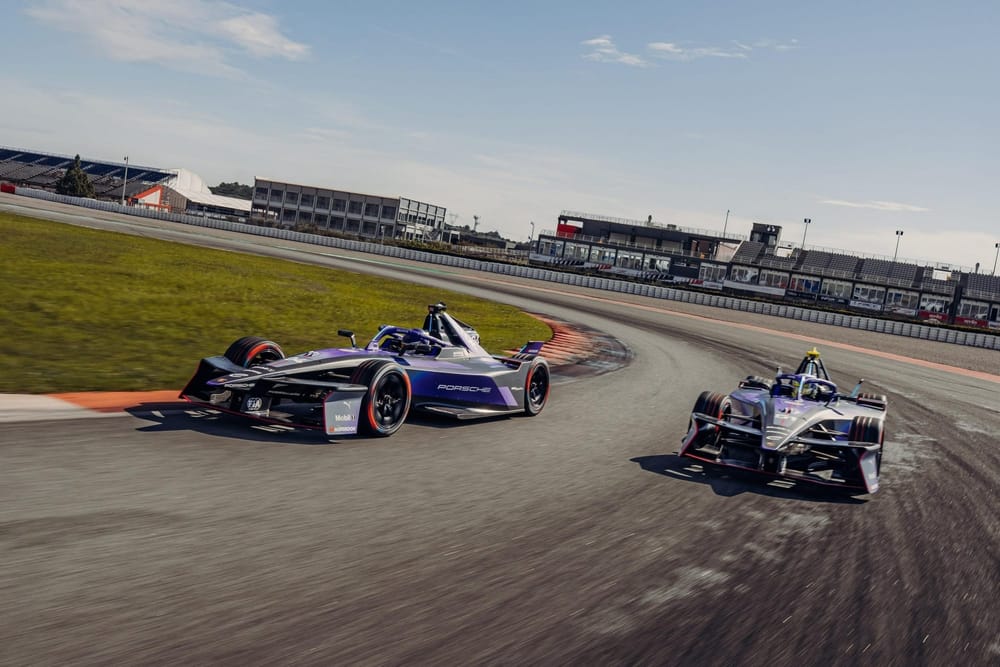Porsche is shaking up Formula E convention in a big way by committing to creating a second factory team from the start of the Gen4 era.
Such a decision inevitably prompts plenty of questions: where did this come from and what was the motivation? How will it work in practice? What does it mean for the state of competition?
Sam Smith answers those questions and more.
The background

At the ExCeL in July 2023, as the chequered flag flew at the end of the first race that weekend, the Porsche senior team slowly took off their headsets, walked out of their offices and into the next pit garage.
There, they were met with wild celebrations after Jake Dennis sealed the drivers' title with Andretti - driving a Porsche. On home ground, the British driver's success was lauded. It was a deserved title; one achieved in a Porsche 99X Electric. But that barely registered.
As the realisation dawned on Porsche, there was a key pivot. Inevitably, Porsche did try to massage and mould the messaging - and Andretti into a true and complete affiliate team. That was natural to some extent but it just didn't come off as expected.
While Dennis sat upon a bling throne, Porsche was in the shadows experiencing an array of emotions; some good, several rueful.
Imagine now that you were works team principal Florian Modlinger or motorsport vice president Thomas Laudenbach, explaining to your board that a driver won a first Formula E title in a Porsche but that no one really noticed.
Just over a year later, Pascal Wehrlein claimed the drivers' title on the same real estate at ExCeL. But Jaguar captured the teams' championship and inaugural manufacturers' trophy, so Porsche's messaging and marketing push was slightly blunted once again, or at least not as sharp as it would have liked.
Jump forwards another 12 months and finally Porsche completed its full set of title successes, this time winning the teams' and manufacturers' crowns. Mission accomplished, or so it looked.
But Monday's announcement that Porsche will enter an additional team to be run from its Weissach base for the start of the 2026-27 season feels momentous and for good reason. The clues as to its genesis, as described above, were really always there.
Porsche is insatiable for success; there is no question it always has been and it always will be. It doesn't want to win once or twice; it wants victory again and again and again.
That's why it's claimed 19 Le Mans 24 Hours successes and a multitude of endurance series titles throughout its remarkable history. It's this tapestry of accomplishments that it wants to achieve again in Formula E and there is little it won't consider in realising that. Which is why Porsche has arrived at this decision.
Ultimately, the biggest boost for the Formula E ecosystem, a phrase that the promoter overuses consistently, is that the stakeholders and the championship itself need stability at this moment in time more than any other, especially as the Gen4 era is around the corner.
As more licenses are secured - in terms of franchises being in safe environments and prudent hands, of which Porsche appears to be in Formula E - is this really a case of the better-off everyone within the ecosystem is? Now, it looks like a key by-product of Porsche's decision is that we are about to find out.
The plan
What Porsche is doing in Formula E for Gen4 in running four cars - and supplying another two to one customer (highly likely to be Cupra Kiro) - is nothing especially new, despite the clear optics of outnumbering its opponents. That will be the case in Gen4 (as it is now) when Porsches will make up a quarter of the grid: six of the probable 24 entrants.
Stellantis has had a two-pronged attack since 2023 at the advent of Gen3, it's just it has a slightly different model in working with privateer teams in MSG and Penske, that it doesn't feel as all-consuming as Porsche's new model.
So too was that the case in 2023, when Jaguar, in all but name, had a two-team attack on its opposition as its works team and Envision combined in a committed sense to develop a strong engineering alliance together. It netted a 50% win rate that season with Mitch Evans (Jaguar) and Nick Cassidy (Envision) taking four wins apiece, with Envision scooping the teams' title as a result.
That relationship changed the following season as Jaguar made Cassidy an offer he couldn't refuse to join the factory line-up. Envision has since struggled to get anywhere near the levels of performance it enjoyed in 2023.
Meanwhile, Porsche embraced another customer team for 2024-25, in addition to Andretti, with an agreement to supply the Kiro team that's partnered with Cupra, a brand cousin to Porsche within the Volkswagen mothership.
This yielded a win at the Jakarta E-Prix in June but despite a close working relationship with Porsche, it was in reality nowhere near what Modlinger and his fellow executives wanted or desired in terms of absolute control and influence. How could it be?
So, the background to Porsche acquiring another franchise in Formula E is actually to prove a point to itself that it can gain extra freedom in developing talent when it comes to drivers and engineers. This is a key point for Porsche because it increasingly prides itself on the human stories as much as the technical ones too.
Ally to these reasons, and of course that of the McLaren licence being available, the relative frugality in cost of Formula E compared to other global championships and a perfect storm gathered recently. It was one which offered a rare opportunity for Porsche to surf a wave it really has always tried to summon up anyway.
The opposition's view

News of the shift in the structure of Porsche's Formula E attack was met with initial inquisitiveness from two of its manufacturer rivals.
Nissan and Jaguar have each taken titles in recent seasons and as manufacturers have a great deal in common with Porsche and its reasons for going racing in Formula E.
Nissan in particular is an interesting case as it enters the 2025-26 season without a customer after McLaren's demise last season. That means it is a rank outsider for manufacturer glory this season before a lap is even completed, and through no fault of its own as the two-season homologation criteria means it is reduced to just two points-scoring cars.
Team principal and managing director Tommaso Volpe told The Race that in his opinion "as long as we are talking about four cars, it doesn't make a huge difference compared to what it could be now: close partnerships between a manufacturer and the customer team, who might compete on track but still have a coordinated partnership and support each other during the championship".
"I trust that everybody is doing a fair job on track, and so I don't think there will be any distortion to the competition because of this," he added.
Distortion, smoke and mirrors, riddles of complexity in how the different Formula E models are employed is part of the fun for those imbued in the paddock politics. Never more so than when it brings forth opinions such as new Jaguar team principal Ian James's.
Just two months into his new role at Jaguar, with a successful few seasons at Mercedes EQ and three more at its successor McLaren stretched out behind him, James's gauge on Porsche's decision is fascinating.
"One of the clear goals of the championship has been to get 12 teams back on the grid again, so first and foremost, if we can do that going into Gen4, then that'll be a huge bonus," James told The Race.
"For the championship as a whole, and for everybody involved, I think that's a real positive.
"In terms of whether it's been healthy for one entity to have such sort of control through the various different teams that they're involved with, we need to see the detail first, and then we can make a call.
"There are different models that are already employed in the championship, and Stellantis is a great example of how one manufacturer can be involved in two separate teams [DS Penske and Citroen presently].
"So, let's wait and see what the details look like when they do come."
What it means for Formula E's health
Formula E DNA, in terms of competitors, has traditionally been for the manufacturer to work with the customer. Porsche will continue to do this but plainly has reprofiled its strategy from a 2+4 to a neat 4+2.
This is simple yet clever, a cute recalculation that doesn't need a mathematician to survey.
Yet it is one not without risk. A solution should ultimately give it greater control and most importantly competitive influence and more agency over its storytelling around its electric motorsport commitment, which so far has been considerable.
There is also a bigger picture in respect of the global health of the Formula E grid, which in reality has been ailing these past few seasons with the McLaren exit, the ill-health of MSG, and some big return-on-investment questions for the bulk of the other teams.
For most teams there has been a kind of stasis, a freezing of growth since the Covid-19 pandemic, the exit of BMW, Audi and Mercedes in 2020 and 2021, and the rebuild of Formula E in that time was seismic for its overall health.
But if Stellantis and Porsche are renewing or expanding their commitments to Formula E then the rub-off for independent teams such as Envision, MSG, Andretti and Kiro is a solidified, and perhaps even increase in, value, at least in time.
This is Formula E's most significant news for a long time, and it could potentially act as a kind of confidence gatekeeper in giving existential assurance to other participants: that if automotive behemoths such as Stellantis and Porsche have such confidence in Formula E then so should they, even if they aren't seeing the returns they wish for just right now.



